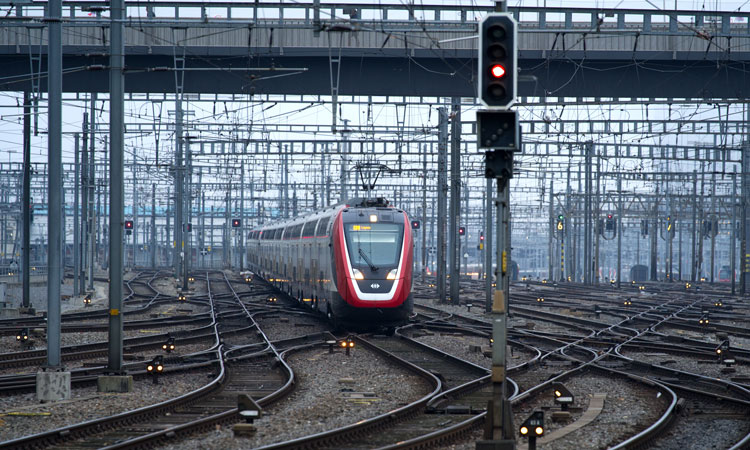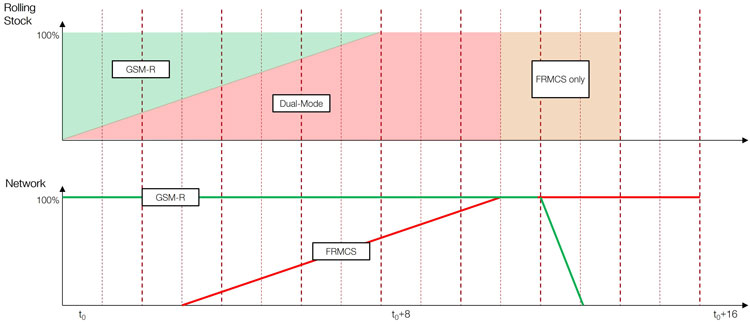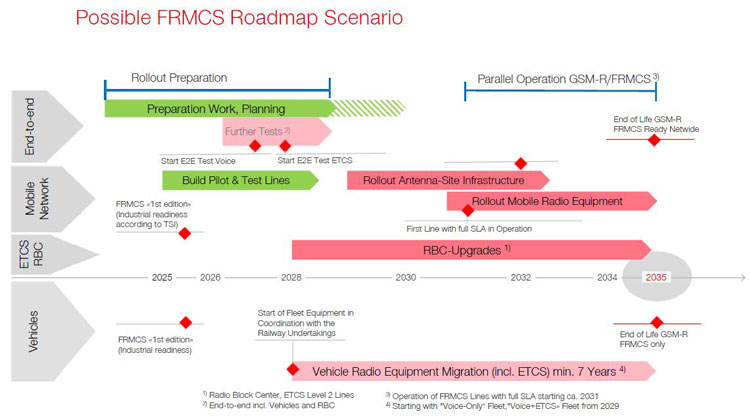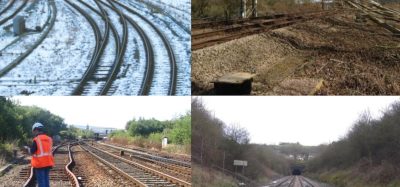Towards FRMCS in Switzerland
Posted: 13 March 2023 | Massimiliano Rizzato, Michael Hopf | No comments yet
Swiss Federal Railways (SBB) colleagues Massimiliano Rizzato, International Telecom Standardisation Manager, and Michael Hopf, System Engineer for FRMCS, explore the case for FRMCS rollout across Switzerland’s rail network and explained the challenges that will come with migration and implementation.


Swiss Federal Railways (SBB ‑ Schweizerischen Bundesbahnen) was founded in 1902. On its 3,265km of tracks, SBB welcomes more than 900,000 passengers each day. Getting customers or their goods to their destination on time is one of SBB’s top goals, with actual train punctuality in 2021 at 91.9 per cent overall. SBB is proud to be one of the most environmentally friendly railways in Europe: as infrastructure manager, SBB manages a 100 per cent electrified network.
Where we stand in Switzerland in railway communication
SBB started the studies and conducted tests for the adoption of FRMCS a few years ago. The aim was to identify the most important parameters to be taken into consideration for radio planning, tendering, rollout, and operation of FRMCS.
SBB uses GSM-R as the mobile telecommunication standard for voice and data. There is full GSM-R coverage on the main lines, with redundancy on the ETCS lines. To provide service in some rural areas, SBB currently collaborates with a national mobile public provider. The service is based on 3G, with ongoing migration to 4G, due to SBB’s partner’s plans for 3G switch-off at the end of 2025. Some systems, such as Passenger Information Systems, are based on public providers’ network services and dedicated antennas on rolling stock for communication purposes.
Similarly for other countries in Europe, Switzerland’s current high-level FRMCS roadmap foresees GSM-R end-of-life by end of 2035. Until then, SBB plans full FRMCS coverage. In collaboration with the Bundesamt für Verkehr (BAV), the Swiss Federal Bureau of Transport, SBB is currently evaluating different deployment scenarios including a fully functional private standalone FRMCS network and a mixed solution, in collaboration with one of the national mobile public providers. The chosen solution scenario will undergo a tendering phase.
The business case for FRMCS
In general, the use cases that support FRMCS adoption are the ‘usual’ railway use cases: voice communication, railway emergency call and ETCS. Then there are additional ones, such as shunting communication (for which SBB also uses with GSM-R). Furthermore, replacement of obsolescent telecom technology, introduction of new operational processes, like ATO/ATS with high GoA levels (e.g., driverless trains) and optimisation of costs and railway network schedules, all urgently push towards a railway telecom infrastructure that can be future proofed, expandable, flexible, cost effective and guarantee the support of broadband communication. SBB acknowledges that this can start with FRMCS, which will support new generation mobile communications based on 5G and its successors and can also support other wireless communication technologies. One of the most important points in favour of FRMCS is that it will not be bound to a single generation of radio technologies or dedicated radio technologies.
Network rollout and migration
SBB started the studies and conducted tests for the adoption of FRMCS a few years ago. The aim was to identify the most important parameters to be taken into consideration for radio planning, tendering, rollout, and operation of FRMCS. The conclusions of these studies were that, based on the EU-allocated dedicated radio spectrum blocks for FRMCS in 1900MHz band (900MHz is currently allocated to GSM-R and will be usable for FRMCS only after the GSM-R switch-off), from the investments as well as the radio performance point of view, among all parameters the intersite distance is the most important parameter to be considered. Because 1900MHz is about double the current GSM-R operational frequency, the intersite distance that guarantees sufficient bandwidth to support critical railways use cases is about half the current intersite distance for GSM-R (as it could be expected, based on Maxwell’s propagation laws). This roughly corresponds to a doubling of the current number of antenna sites, or in terms of investments, to building a fully new network on the side of the existing GSM-R one. Similar studies and tests conducted by other infrastructure managers in Europe showed similar conclusions. Optimisations can be achieved with usage of new technologies (5G and successors, new antennas, etc.), but in general there are no huge margins to reduce the need for investments. Doubling a network in about seven to 10 years is a big project which is taken very seriously at SBB, and it includes among others:
- Tendering (rollout services, hardware, radio planning services, etc.)
- Radio Network Planning
- Migration planning
- Acquisition of building permits
- Rollout of test and production lines
- Introduction of new operations processes
- Acquisition of new know how and personnel.
Rolling stock migration
The seven-year rolling stock migration period in the current Roadmap Scenario might seem long, but it includes the installation and/or replacement of mobile antennas and equipment. This is time-consuming and expensive and, as such, needs careful planning on every fleet. The migration start is subject to external constraints: a full standard for ETCS over FRMCS is expected with the CCS TSI 2025; ETCS and FRMCS equipment providers may need up to two years from then to adapt their existing portfolio or to develop new products; one more year might be needed for industrialisation and possibly one more for the homologation process. This shows that synergies and parallelisation of processes are needed to achieve the roadmap milestones.


On-board migration.
Challenges
In general, challenges for FRMCS mainly originate from matching railways and telecom technology lifecycles. Lifecycles for railways span 30 to 50 years, whereas mobile telecom lifecycles reduced overtime from 25 to seven years (from 2G to 5G) and are projected to further reduce with upcoming generations. 2G-based GSM-R would be already long considered obsolete in the general mobile market today. Vendors of GSM-R equipment ‘promised’ to be able to continue production/support until 2030/2035 (at increasing costs). FRMCS, with its promise of ‘abstracting’ from the underlying mobile technology (support for any generation, starting with 5G) offers a solution to this issue, but the timeframe for its implementation, before GSM-R becomes unmanageable, is tight. What makes it tight is that today telecom chipsets producers and equipment providers cannot yet offer FRMCS products and will not be able to do so until arguably 2025. This is because the currently available specifications don’t cover the full range of functionalities needed by Infrastructure Managers and Railway Undertakings for the introduction of FRMCS. On one hand, the current FRMCS V1 specification is a success because it marked the ‘legal anchoring’ of FRMCS in the EU normative frame (CCS TSI 22) as the mobile communication system of choice for Europe. On the other hand, it only includes support for main functionalities: ETCS, REC and voice. Version 2 of the FRMCS specifications, planned for end of 2023, will bring the rest of the functionalities needed to make the system completely usable and interoperable: border crossing management, parallel operation of GSM-R and FRMCS for the migration period, coexistence of different networks at the borders (an issue for SBB, with two triple borders areas and borders with 5 countries), usage of Public Providers’ mobile networks for FRMCS (so-called national roaming). V2 availability at the end of 2023 means that telecom chipsets producers and equipment providers will not start prototyping before 2024, and infrastructure managers and railway undertakings testing, and subsequent rollout will not start before 2025/2026 (for ‘early adopters’). SBB, in agreement with BAV, which finances the railway infrastructure in Switzerland, doesn’t plan for early adoption, though there is small margin for delaying the introduction of FRMCS to be ready for 2035. In this sense, SBB will start tendering for what is possible in terms of equipment and services as soon as 2024. In addition to these challenges, not to forget are also:
- Migration of current on-board equipment with dual mode GSM-R/FRMCS-capable devices to support operations in mixed scenarios during FRMCS rollout
- High expectations for digitalisation, which already prefigure high bandwidth demand, impossible with the frequency blocks allocated until today for licensing to railways. Additional bandwidth will be necessary, be it obtained by making use of licensed or unlicensed spectrum or ‘renting’ it from public providers (roaming)
- Know-how loss: the obsolescence of GSM-R implies also that it’s not anymore in universities’ curricula, so the active population of experts will slowly reduce with retirements in the next 12 years.

Roundup
GSM-R has been in use in Switzerland for approximately 20 years. The underlying 2G standard dates back to the 1980s, so it’s getting more expensive and challenging to keep this communication system operating. A newer telecommunication standard is necessary. Not only for technical and financial reasons, but also to lower the hurdles for future migrations.
Indeed, FRMCS will be also the basis for further innovations, like Automatic Train Operation (ATO), which might help in reducing overall operating costs and optimising the capacity of Switzerland’s rail network. FRMCS also caters for the requirements of digitalisation and future readiness.
SBB and BAV are fully aware of the investments and the challenges of the implementation of FRMCS, but there is conviction that the hurdles can be overcome, and the investments will pay out in the long run.
The information and opinions expressed in this article are those of the authors and are by no means an official statement from Swiss Federal Railways (SBB) or associated organisations mentioned. Figures/graphics included in this article are projected forecasts based on author knowledge.




Global Railway Review Autumn/ Winter Issue 2025
Welcome to 2025’s Autumn/ Winter issue of Global Railway Review!
The dynamism of our sector has never been more apparent, driven by technological leaps, evolving societal demands, and an urgent global imperative for sustainable solutions.
>>> Read the issue in full now! <<<
Issue
Related topics
European Rail Traffic Management System (ERTMS), European Train Control System (ETCS), Future Railway Mobile Communications System (FRMCS), Global System for Mobile Communications – Railway (GSM-R), Signalling, Control & Communications







